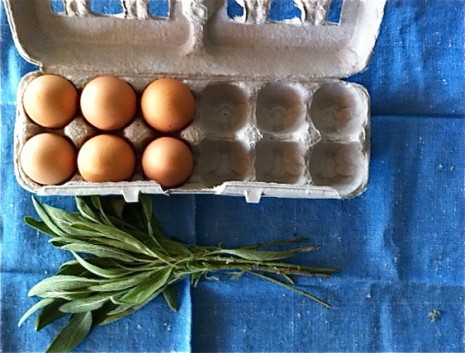SAGE ADVICE FOR OCTOBER
October is a swing month. The trees are reluctantly turning red and orange and yellow. Kitchen gardeners are sowing fast-growing radishes and lettuces while simultaneously harvesting pumpkins and cauliflower. Even when the weather is fine, there’s an edge to the air, a sharpness, when you take a deep breath.
October, with its fat-bellied letters, is also the roundest month, with full, mellow flavors. Right now, I can’t get enough sage, with its warm, almost musky, spiciness. Last spring, I bought every variety I could find because the plants were so beautiful, and they obliged by growing like gangbusters. I got hooked gradually, plucking pretty leaves of variegated golden sage to scatter over platters of fried green tomatoes. Then I started substituting a sprig of pineapple sage for the mint in tea, both iced and hot.
The common sage shown above has a great graphic quality. I’ve always thought it a pity that most recipes call for it chopped, especially when you have a ready supply of the young green leaves, which aren’t as pungent or furry as mature ones. They make a terrific substitution for parsley in parsley-leaf potatoes, a simple, effective party-trick recipe from Gourmet.
That decal-like quality comes in handy for other things as well. I was reminded of our friend Josh van Gelder, an English photographer with a fabulous blog called The Curious Eye. A few years back, he wrote about eating fried eggs with sage at Leila’s Shop, in Shoreditch. The idea was intriguing. Sage is a standard seasoning in sausage, but the notion of eating such a strong-flavored herb more or less intact first thing in the morning isn’t everyone’s cup of tea.
Of course, it isn’t precisely new, either. A look through Will Weaver’s annotated translation of Sauer’s Herbal Cures: America’s First Book of Botanic Healing revealed this tidbit of 18th-century advice: “Some people imagine themselves safe that by eating a few sage leaves with salt in the morning before breakfast, they will be protected the whole day from contagion and miasma.” Whatever it takes.
My déjà vu moment occurred the other day, when I took a carton of eggs out of the fridge and a bag of our fresh garden sage tumbled out with it. I didn’t even ask Sam what he wanted for breakfast, but just got busy putting it on the table.
Now, perfection in fried eggs is a matter of individual taste. People generally agree that a properly runny egg yolk should be in a state of suspended animation until you sink a fork into it, but I happen to like my yolk surrounded by a crisp, almost frizzled border of white; Sam prefers his with the white just set and very tender. Breakfast sandwiches, obviously, call for eggs over easy; I have two smallish wooden spatulas that are just the tools for the job. As far as steam-frying—that is, cooking them covered—goes, I’ve never quite gotten the hang of it. Although the resulting white is perfectly cooked through, I’m not crazy about the film of white that creeps over the yolk, and I never know what to do with the condensed steam that accumulates on the underside of the lid. Even though I uncover the eggs very quickly, I always get them wet.
But no matter how you like to fry your eggs, you’ll find this embellishment delicious, especially if you start with fresh, good-quality eggs.
Sage-Fried Eggs
This is also a terrific option for a quick, inexpensive, nourishing supper. Put the fried eggs on top of hot, buttery spaghetti. Cut the egg into manageable pieces and coat the strands of pasta with the yolk and fat from the skillet. Add some Parmigiano-Reggiano, if you like, or maybe garlicky croutons or toasted fresh breadcrumbs.
bacon drippings, butter, or olive oil for frying
1 or 2 large eggs per person
about 3 sage leaves per egg, rinsed and patted very dry
salt and pepper
Heat your fat of choice in a skillet over moderate heat. When the fat is good and hot but not smoking, ease the eggs into the pan. (I like to crack each egg into a custard cup first, but do it your way.) Immediately put a few sage leaves, top side down, into each liquid white. With your fingers, flip over the leaves so they integrate themselves into the whites as they firm up. It takes about 3 or 4 minutes to fry an egg until the white is nicely set, with a still-runny yolk. If you like your egg to crisp up around the edge, like I do, it takes a bit longer.
Posted: October 19th, 2011 under autumn, cooking, Gourmet magazine, recipes.


